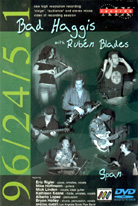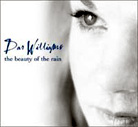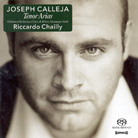 |
| September 1, 2004 Once Again in the Vanguard Like wine and Casablanca, the recordings made by Maurice
Abravanel and the Utah Symphony Orchestra seem to improve with time. Far from being left
behind, this magnificent library of sessions is now leading the classical music catalog
into the realm of high-resolution sound. Like wine and Casablanca, the recordings made by Maurice
Abravanel and the Utah Symphony Orchestra seem to improve with time. Far from being left
behind, this magnificent library of sessions is now leading the classical music catalog
into the realm of high-resolution sound.
Abravanel gave up more prestigious positions in larger cities to become music director of the USO. Recording producer Seymour Solomon, founder of the Vanguard Recording Society, had made records with such world-class orchestras as the London Philharmonic and the Vienna State Opera Orchestra. Solomon saw promise and potential in Utah, and he and Abravanel made recording history; a miracle in the desert. Abravanel increased the orchestra’s quality of playing fourfold, and Solomon captured the orchestra in rich, full, detailed sound -- engineering that has yet to be bettered, and to this day is seldom equaled. True to his company’s name, Solomon was in the forefront when it came to new technical opportunities. Vanguard was one of the first companies to embrace Dolby Noise Reduction for its master tapes, and one of the pioneering organizations to record in quadraphonic sound. It seems just, then, that Vanguard recordings should lead the way in the high-resolution DVD-Audio format. Solomon passed away recently, and his company was sold to Artemis Classics, which has released several of the original multichannel tapes on SACD. More are promised for fall, including both 4.0- and 3.0-channel recordings. Vanguard recordings are being licensed and released on DVD-Audio by Silverline, in its Silverline Classics series. Most of these feature Abravanel and the USO, and include the complete symphonies of Brahms and Sibelius and the first four of Mahler. In addition, there are individual discs devoted to the music of Leroy Anderson, Rachmaninoff (Symphony 3), Tchaikovsky, Berlioz, and Vaughan Williams. With the exception of Tchaikovsky’s Swan Lake, which exhibited glitches on three different players, the quality is top-drawer. (Silverline informs me that Swan Lake has been reauthored; the defective discs should have been replaced in all stores by the time you read this.) Unlike Artemis, which has a policy of using the channel configuration of the original master tape for its SACD releases, Silverline has remixed all sessions to 5.1 channels. I think these sound wonderful. The center channel anchors the front stage, and the surrounds provide realistic ambience. For purists, Silverline has also included 24-bit/96kHz two-channel tracks, and Dolby Digital 5.1 and 2.0 tracks are provided for those who don’t have a DVD-A player. There are a few video extras, including a eulogy for and comments about Abravanel by various members of the USO. I would start with the Vaughan Williams collection [Silverline 288239-9], which includes a bracing performance of Symphony 6, a rousing Dona Nobis Pacem, and downright seductive readings of Flos campi and the Five Variants on Dives and Lazarus. The balance of chorus and orchestra is just right in the Dona Nobis and Flos campi, and the percussion is awesome throughout, with perhaps the most realistic bass drum ever heard in the Flos campi. I would then turn to the disc of Leroy Anderson favorites [Silverline 288341-9]. These encore pieces have never been performed with such flair and polish, not even by the Boston Pops, for which most of them were written. And Solomon had a field day capturing the syncopated clock, typewriter, sand block, and pennywhistle sounds called for in the scores. These two discs can’t be beat. The Berlioz Requiem also merits investigation [Silverline 2388236]. I reviewed the SACD last month for GoodSound!, and find this DVD-A release of the original "quad" tape just as stunning. From there I would go to the magnificent recording of Mahler’s Symphony 2 [Silverline 288244-9], with the fresh, young Beverly Sills as soprano soloist, and then on to the Brahms and Sibelius cycles. The USO is outclassed by others in this standard repertory in terms of sheer proficiency, but Abravanel brings lots of energy and insight to his readings, and the engineering team has caught details overlooked in other recordings. Often, the sound is so good that it makes up for any orchestral deficiency. And don’t forget Rachmaninoff’s Symphony 3 [Silverline 288242-9]! When it came out, it was the best reading around -- yet another amazing surprise from Utah. Now we have recordings conducted by Previn, Zinman, and others, but I don’t believe any of them is better recorded than this one. Two of Abravanel’s great strengths were the musics of France and the United States. It seems curious that Silverline has overlooked his virtually definitive recordings of Honegger’s La Roi David, various compositions by Milhaud and Satie, and Copland’s Lincoln Portrait (with Charlton Heston). Perhaps someday they’ll receive the 5.1-channel DVD-A treatment; in the meantime, Silverline has promised to release the rest of Abravanel’s cycle of Mahler symphonies. By the time you read this, Silverline will have released DVD-A versions of Sir Adrian Boult and the London Philharmonic’s recordings of Beethoven’s Symphonies 3, 5, and 6 (Symphony 7 will follow later this year). Each is an audiophile treasure to look forward to in a high-resolution remix. Other non-Abravanel recordings need the DVD-A treatment as well, such as Vladimir Golschmann’s definitive series of the music of Samuel Barber. If Silverline asks, I’ll make them a list, but for now, there are sufficient riches to enjoy. Three recordings exemplary in both performance and sound made my cut this month:
I was impressed with AIX Records’ Tribrid discs from the start. Though I can’t fault producer Mark Waldrep’s engineering of pop and jazz artists, I’ve felt that his keen ears have been often wasted on groups not artistically worthy of his technical abilities. I’m happy to report, then, that Bad Haggis is a first-rate Celtic jazz fusion band that manages to bridge all sorts of cultural and artistic gaps and come up smelling like a rose with healthy thorns. The playing is assured and energetic. The heady instrumentation includes pipes, whistles, fiddle, guitars, electric bass, percussion, and drums, augmented by bagpipes. The many different instrumental timbres are perfectly captured by Waldrep’s impressive engineering. Waldrep covers all the bases. The main high-resolution tracks are a 5.1-channel mix with a stage perspective, the instruments placed naturally all around the listener. Don’t like that? There’s also a clean-as-a-whistle two-channel, 24-bit/96kHz mix. Can’t play high-resolution discs yet? There are DTS and Dolby Digital tracks to keep you happy until you can. Want to see what the performers look like? There is full-motion video of all sessions on the DVD-Video side. There is also a detailed biography of each musician. Where most companies might give you a dry, written history, AIX offers live video interviews with each musician, even a discussion of the instrument(s) he plays. In addition, there are photo galleries, rehearsal footage, and much more -- all you could ever want to know about the sessions and artists and equipment that produced this disc. An AIX disc is to music what a Criterion DVD is to film, and that’s saying a lot.
This is a beautiful album of acoustic country pop, most of it written by Williams. As an artist, Williams sells a lyric by treating it straightforwardly, and her simple, unaffected manner is most appealing. She uses some classy backup artists, including Alison Krauss, Cliff Eberhardt, John Medeski, John Popper, and Béla Fleck, and none has ever sounded better than in the high-resolution DVD-A medium. The 5.1-channel mix is rich, with lots of surround, but the balances are so carefully adjusted that none of it seems unnatural. There’s lots of bass, as if the instrument itself were right in your listening room. Keep your listening level conservative till you’re familiar with the recording; when you find just the right volume for your room, everything will fall into place as a sweet listening experience. The meager DVD-Video features include still-frame photos and text not printed in the insert.
Joseph Calleja, from Malta, has made quite a splash in international circles. He made his US debut in 2000 at the Spoleto Festival in Charleston, South Carolina, in Puccini’s Gianni Schicchi. This recital features lyric tenor arias from the Italian repertory, a genre Calleja seems born to sing. His voice is light and appealing, with a heroic ring on the top notes that is reminiscent of the young Giuseppe di Stefano. The big feature here is a section containing all the tenor arias from Rigoletto, an opera Calleja has sung on stage with great success. His lyrical approach allows the phrases to spin out in a natural manner that’s wonderful to hear. The orchestra, formed in 1993, sounds excellent under the direction of its chief conductor, Riccardo Chailly. Even more impressive is its adjunct chorus, which makes brief but telling appearances in the Rigoletto excerpts and the closing act aria from Donizetti’s Lucia di Lammermoor. The 5.0-channel recording, 96/48 PCM, seems just right: rich, warm, and detailed. There is perfect balance between singer and orchestra, and the surrounds are discreetly used to convey a sense of front-stage presence and hall ambience. Calleja is only in his 20s. If he pampers his beautiful lyric voice, resisting the ever-present urge to tackle unsuitable dramatic roles, he should be a force in opera for some time to come. ...Rad Bennett
Ultra Audio is part of the SoundStage! Network. |
 Bad Haggis with
Ruben Blades: Span
Bad Haggis with
Ruben Blades: Span Dar Williams: The
Beauty of the Rain
Dar Williams: The
Beauty of the Rain Joseph Calleja: Tenor Arias
Joseph Calleja: Tenor Arias